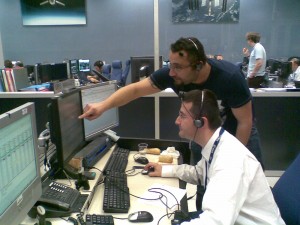We received a nice note yesterday from ESA’s Jean-Michel Bois, Mission Director at ATV-CC, explaining details on the work involved with planning and scheduling communications with ATV-2.
Since ATV separated from its Ariane launcher on 16 February, all communications between ATV Control Centre (ATV-CC) in Toulouse and the vessel – receipt of telemetry and sending of telecommands – have been achieved via data relay satellites. Two relay satellite systems are in use: NASA’s Tracking and Data Relay Satellite System (TDRSS) and ESA’s own Artemis satellite.
Jean-Michel writes:
During the current ‘phasing’ period (i.e. manoeuvring so as to match the ATV orbit with that of the ISS), ATV is communicating primarily via NASA’s TDRSS. ATV-CC is using Artemis as a back-up and as a complement when TDRSS communication slots are not available.
The TDRSS satellites can ensure communication during ATV’s complete orbit (about once every 90 minutes) thanks to the fact that the system comprises multiple satellites. These are set in a ring in permanent geosynchronous orbit with at least one looking down on all regions the Earth (and on ATV as well!).
ESA’s single Artemis satellite is also in geo-orbit, located at 21.4ºE, and offers around 40 minutes of continuous contact during each of ATV’s orbits. ESA’s Redu station, in Belgium, houses the Artemis mission control room (more details here).
At ATV-CC, it’s the task of mission planners and the ‘Ops Manager’ on console to prepare and manage the communication coverage; this team works in very close coordination with their NASA and Redu counterparts.
When a TDRSS or Artemis schedule has been agreed, the mission controllers at Toulouse coordinate with controllers at NASA’s ISS Mission Control Center in Houston (MCC-H), ESA’s Columbus Control Centre (Col-CC) near Munich, Germany, and Redu to configure the ground systems and the relay satellite links to provide the planned telecom services.
Scheduling communications for ATV takes a lot of work and knowledge – to cater for all the constraints from ATV needs and requirements in terms of bandwidth, positioning, tracking and more. It’s also necessary to take into account all the other relay satellite users. For instance, Artemis also provides support to ESA’s Envisat Earth observation satellite, and the TDRSS satellites support regular ISS communications, Shuttle flights and numerous other US satellites. Together, ATV-CC, MCC-H and Redu station assess the various requests, optimise the utilization of the satellites, ensure there will be no conflicts and try to satisfy everyone involved – all of whom have good reason to ask for relay satellite support. When everything is ready, communication support requests for ATV are formalized via a standard data file exchange, called an ‘SHO’ (Schedule of HandOver).
It also helps that before ATV’s mission started, all the required relay satellite utilization slots had been largely foreseen, discussed and agreed upon between the various control centres. But these earlier prepared schedules cannot simply be applied now due to the ATV launch delay, and so to a large extent, relay satellite usage must be again be negotiated and agreed upon.
Since ATV launch on 16 February, teams have been working intensely each day to reallocate relay satellite resources in order to cope with ATV needs. Thanks to excellent efforts made by all the partners, ATV continues to be safely monitored on a permanent basis.


 Automated Transfer Vehicle page
Automated Transfer Vehicle page ATV blog archive
ATV blog archive
Discussion: 4 comments
are the links between ATV and sats ISL type links?
and by that I mean inter-satellite links
The TDRS System is one of the ISLs.
And yes, we could also consider that the links ATV-TDRSS or ATV-ARTEMIS are also similar to an ISL, even if this notion is more related of comm between fixed satellites in order to ensure a global (or extended) coverage. Here we are talking about a mobile vehicle, as the Shuttle, which is actually not a pure “satellite” !
great, thanks for that info!
RN